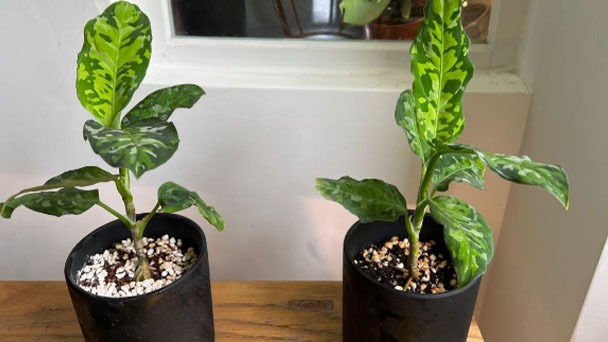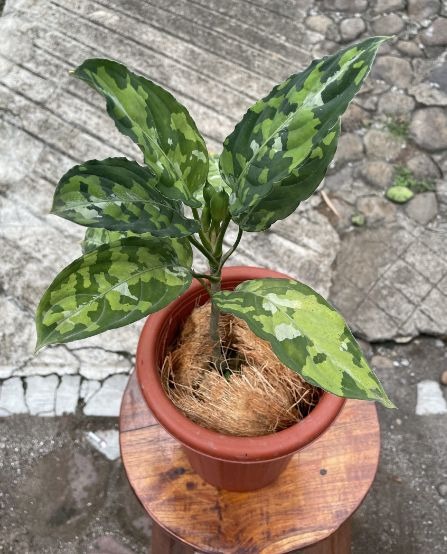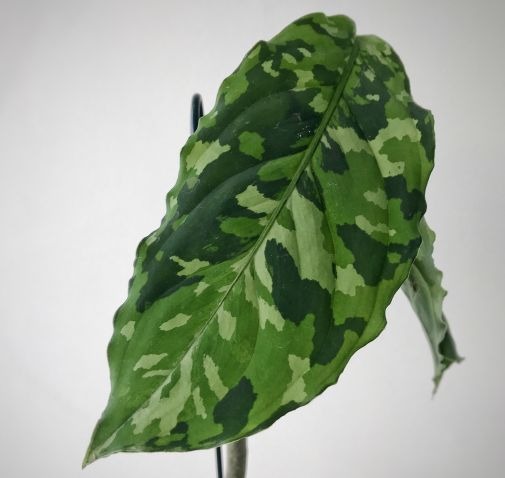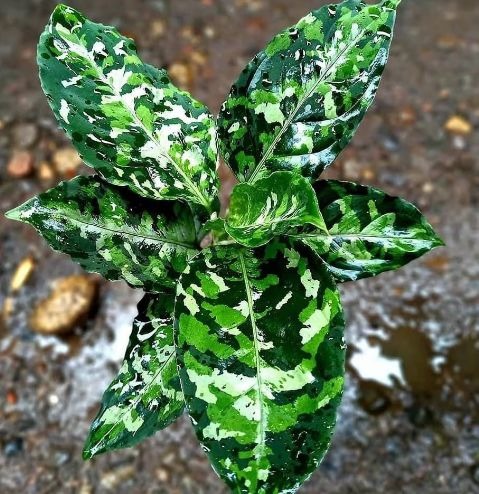How to Grow & Care for Aglaonema Pictum Tricolor
Written by Ivy
Jan 07 2023

Aglaonema Pictum Tricolor, also known as the "camouflage plant," is a rare houseplant highly prized for its unique foliage.
Continue reading to learn how to propagate this rare plant as well as how to maintain the camouflage leaves of Aglaonema Pictum Tricolor.

Is Aglaonema Pictum Tricolor Easy to Care For?
If you provide it with the conditions it needs to thrive (which I'll describe in this post! ), Aglaonema Pictum Tricolor is actually a fairly simple plant to take care of.).
Rare plants are not always difficult to maintain, contrary to popular belief.
Because everyone kills houseplants when they first start out learning, I would only suggest this plant to a beginner if you can find it for a reasonable price.
Aglaonema Pictum Tricolor Care Guide
Soil
An Aglaonema pictum tricolor grows best in rich, well-draining soil that contains a blend of orchid bark, perlite, and peat.
They dislike being in compacted ground.
For these plants, a combination of peat, perlite, and orchid bark works well.
They are subtropical plants that require a lot of humidity and frequent watering, so good drainage is crucial.
Your potting mix needs to be airy and rainwater-well to prevent issues like overwatering and root rot.
If the water starts to drain out of the pot quickly after you water your plant, the soil is likely to be well-draining.
Light
Aglaonema pictum tricolor requires direct sunlight that is bright.
Avoid direct sunlight because it will burn the plant's leaves.
In the understory of extremely humid tropical forests, Aglaonema pictum can grow in low light.
Under the circumstances of a houseplant, this does not imply that you should only provide minimal light.
In comparison to grow lights or window-mounted lights, the sunlight in nature is much stronger.
The Aglaonema Pictum Tricolor is a variegated plant, so it requires bright, indirect light to thrive and preserve its lovely variegation.
If you can, diffuse the light a little to prevent it from being too strong or direct.
Watering
For an Aglaonema pictum tricolor, keep the soil just barely moist but avoid overwatering.
Maintain a slight moisture in the soil, but water less during the winter.
Whenever the topsoil is on the verge of drying out, water frequently.
Both dry spells and overwatering are difficult for these plants to handle.
My personal experience has taught me that they are extremely picky in this area, and either over- or underwatering could result in you losing this pricey jungle gem.
Temperature
For an Aglaonema pictum tricolor, maintain a temperature of 60°F to 85°F (16°C to 29°C).
An environment that is warm is necessary for this subtropical plant.
It won't tolerate cold spells very well. Avoid temperatures below 50°F (10°C) and make sure that winter temperatures stay in the range of 60°F to 64°F (16°C – 18°C)
Humidity
For an Aglaonema pictum tricolor, a humidity level above 65% is advised.
For this one, keep the humidity levels high.
Aglaonema pictum tricolor thrives in terrarium environments with high humidity levels.
After all, this is a subtropical plant that can be found in the Nias and Sumatra jungles.
Above 65%, high to very high humidity is recommended.
My Aglaonema Pictum Tricolor thrives in the terrarium I keep it in, where the humidity level is kept above 90%.
If you are unable to keep your Aglaonema in a terrarium, make sure to provide a pebble tray with water underneath.
These houseplants have a tendency to grow crisp leaves that will quickly wilt if the humidity level is too low.
How Do You Propagate Aglaonema Pictum Tricolor?
Usually, stem cuttings or plant division are used to propagate Aglaonema Pictum Tricolor.
Propagate Aglaonema Pictum Tricolor by Stem Cuttings
- Find a node on the stem of an established, healthy plant. Nodes are the bumps along the stem where new growth, such as leaves and roots, are produced.)
- Use a pair of clean, sharp scissors to cut off the stem below the node (meaning, the node should be ON the part you cut off)
- Place the cutting into a container of moistened potting mix, making sure at least one node is buried
- If you prefer, you can root the cutting in water first and then transfer it to potting mix once the roots are a few inches long
- Put the cutting in an area that is warm, humid, and has bright to moderate indirect light. Keep the potting mix lightly moist as the roots develop
- Give the cutting a gentle tug after about a month. If you feel resistance, a root system has developed and you can start treating your stem cutting like a normal plant
Propagate Aglaonema Pictum Tricolor by Division
A few sections of the plant must have their own root systems in order to divide it. As a result, you must wait until your plant has slightly matured before dividing it.
Typically, division occurs during repotting so that each section can be planted in a separate pot.
- Remove your plant from its pot
- Identify one or more sections that have their own root systems (depending on how many separate plants you want)
- Gently separate the root system of each section from the mother plant
- If your fingers are unable to remove them, use clean, precise scissors to do so. Try to do as little damage to the roots as possible
- Put each section into its own suitable sized pot. A large pot may cause overwatering, so keep them small. Make sure each pot has a drainage hole, too
- Water each new plant and the mother plant, and care for them how you normally would
- Give the mother plant and the new plants time to get used to each other. They might be in shock, so it's normal for new growth not to appear right away
Can You Grow Aglaonema Pictum Tricolor Seeds?
Of course, you can also grow this plant from seeds, but doing so usually takes a lot of time and effort.

When Should You Repot An Aglaonema Pictum Tricolor?
At most every other year, you should repotted your Aglaonema Pictum Tricolor. It doesn't need to be repotted frequently because it prefers to be rootbound.
However, eventually it will outgrow its pot and require repotting. You can check if your plant is very rootbound by looking for the following signs:
- Lots of roots coming out of the pot's drainage holes
- Slipping the plant out of its pot and checking if the roots are significantly swirled around the outside of the soil and bottom of the pot
- Stunted or sad-looking growth is also sometimes a sign that your plant is too rootbound
When your plant is actively growing, try to repotting it in the spring or summer. Use a pot one size larger than the one it is currently in, and make sure it has good drainage.
Because they dry out more quickly and reduce the risk of root rot, I really like terra cotta pots!
How to Prune Aglaonema Pictum Tricolor?
For this plant, only the dead or dying leaves should be removed after they can be gently pulled off. Pruning is not required. If you are unable to remove a leaf by pulling it, simply cut it off at the base with a fresh pair of scissors.
If your plant blooms, you might want to remove them with a pair of fresh, accurate scissors. On occasion, the energy of the plant's rest is sucked away by the blooms.
You want the foliage to have as much energy as possible because this Aglaonema is prized for its foliage rather than its flowers.
How can I get a bushy Aglaonema?
There is no way to prune the Aglaonema Pictum Tricolor to encourage bushier growth, unlike some other plants, because it won't grow any bushier than it already does.
You CAN bury the stem deeper in the potting mix if your plant is growing leggy (stretched-out stems with fewer leaves). The nodes along the buried portion of the stem will produce roots.
Aglaonema Pictum Tricolor Flowers and Foliage
The leaves of Aglaonema Pictum Tricolor have a camouflage pattern and come in three shades of green: light green, green, and dark green.
This plant occasionally produces a spathe and spadix, but the blooms are not nearly as stunning as the camouflage foliage.
As I mentioned earlier in this post, you might think about using a pair of clean, sharp scissors to trim the blooms off so they don't sap the plant's energy.
Cleaning the Leaves
When you see dirt or grime building up on your plant's leaves, gently wipe them down with a damp cloth while holding the underside of the leaf in place with your other hand.
The plant will be able to photosynthesize more effectively if the leaves are kept clean and free of layers of muck.
Growth Rate and Size
Typically, the Aglaonema Pictum Tricolor will only reach a maximum height of two feet.
Although this plant grows fairly slowly, you can encourage it to grow as quickly as possible by giving it the best growing conditions.
Is the Aglaonema Pictum Tricolor Toxic?
Unfortunately, Aglaonema Pictum Tricolor is toxic, so take care to keep it out of the reach of children and pets.

Problems and Pests
My Aglaonema Pictum Tricolor is Losing Leaves
It should be fine, so relax. Stress can cause this plant to lose some of its leaves. It has a decent chance of growing new leaves if it loses all of its leaves but the stem remains.
Why Aglaonema Pictum Tricolor Drooping Leaves
Underwatering is the most frequent cause of drooping leaves, but overwatering may also be to blame if root rot is beginning to appear. Drooping leaves are another symptom of excessive direct sunlight.
Why My Aglaonema Pictum Tricolor Have Brown, Crispy Leaf Edges
Your plant is probably too dry; the cause of this may be low soil moisture or low humidity. In order to ascertain the root of the problem, sheck the soil of the plant and the humidity level in your house.
Why My Aglaonema Pictum Tricolor Have Yellow Leaves
Overwatering is the most common cause of this, especially for plants that like to remain moist because it can be hard to distinguish "moist" from "wet."
Before you water your plant, use your finger to feel the soil to determine whether it actually needs it. This will help you avoid this.
Pests on Aglaonema Pictum Tricolor
For this plant, pests are not a major issue, but as with any indoor plant, there is always a chance. For general pest prevention and control, I really enjoy using Bonide Systemic Houseplant Insect Control.
Conclusion
Provide a well-draining potting mixture made of orchid bark, perlite, and peat, as well as bright indirect sunlight, for the care of Aglaonema pictum tricolor. When watering, keep the soil just barely moist. The ideal temperature range is between 60 and 85 degrees Fahrenheit (16 and 29 degrees Celsius), with a humidity level of at least 65%. During the growing season, fertilize using a fertilizer at half strength every two weeks.
Latest Updated
- Benefits of Bugleweed - 7 Science-backed Health Benefits
- Bugleweed Dangers & Side Effects - Is It Poisonous?
- How to Plant Evergreen Trees - What You Should Know
- When to Plant Evergreens - Grow Guide for Evergreen Trees
- 12 Wonderful Evergreen Shrubs for Your Garden
- 12 Popular Evergreen Plants with Pictures for Beginners
- When And How To Prune A Lilac Bush Like a Pro
- How to Grow & Care for Lilac Vine (Hardenbergia Violacea)
- Japanese Lilac Tree (Syringa Reticulata) Care & Propagation Guide
- Shumard Oak Pros and Cons - What to Know
Popular Articles
- Winter maintenance of Antirrhinum Majus
- How to Grow Terminalia Mantaly Tree
- How to Grow and Care for Crossostephium Chinense
- How to grow Antirrhinum Majus in spring
- Peristeria Elata (Dove Orchid) Profile: Info & Care Guide
- Underwatered Snake Plant (Sansevieria Trifasciata) - Signs And How To Fix
- How to Care for Brazilian Jasmine Plant (Mandevilla Sanderi)
- How to Grow & Care for Graptopetalum Purple Delight in Summer
- Rosa Chinensis (China Rose): Plant Growing & Care Tips
- How to Care for Baby Sun Rose (Aptenia Cordifolia)